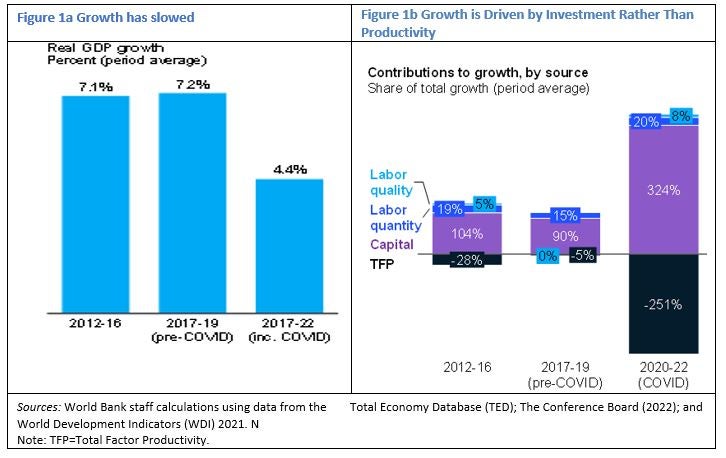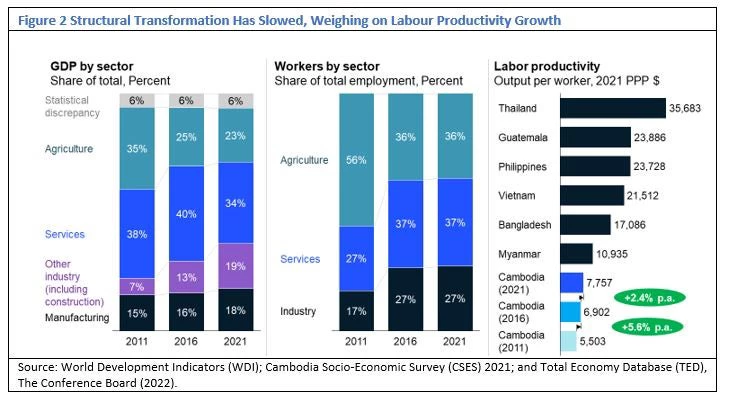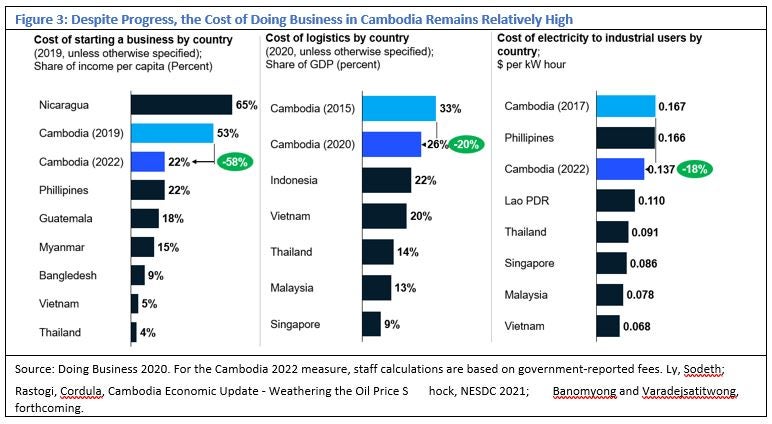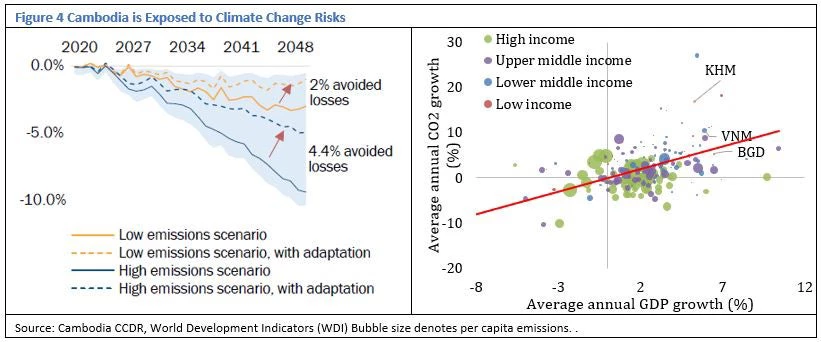 Aerial view Skyscrapers of Phnom Penh city with downtown, riverside and sunset. © Nhut Minh Ho/Shutterstock
Aerial view Skyscrapers of Phnom Penh city with downtown, riverside and sunset. © Nhut Minh Ho/Shutterstock
Cambodia has made remarkable development progress over the past decades. In the decade prior to COVID-19, it sustained an average growth rate of seven percent per year, all while keeping public debt below 40 percent of the GDP. This rapid growth translated into equally rapid gains in poverty reduction with the poverty rate in Cambodia declining to 18 percent in 2020 from 26 percent six years earlier. This means 1.2 million fewer Cambodians live on $2.70 a day or less. Despite this impressive achievement, 50 percent of Cambodians still live on only $4.15 or less a day. To achieve its vision 2030 of becoming an upper middle income country and to further reduce poverty, Cambodia needs to maintain a high rate of growth.
However, as 2023 draws to a close, Cambodia’s economy has been slowing down. The World Bank projects growth for this year at 5.4 percent, higher than growth in the last three years, but still a far cry from the 7.2 percent average annual growth achieved in the decade before the COVID-19 pandemic (Figure 1a). Much of this slowdown has to do with a challenging global environment. Weighed down by tight financing conditions, high debt and growing geopolitical and economic tensions, global growth is expected to continue to slow next year for a third consecutive year. Anaemic global trade and investment flows dim the short-term outlook, but also raise concerns over longer-term prospects, especially for developing countries. As a small open economy, Cambodia has not been insulated from these global developments.
While the external environment has contributed to a cyclical slowdown this year, it has also exposed emerging structural challenges at home. These challenges predate the pandemic, but were masked for several years by rapid capital inflows that fueled a construction boom until COVID-19. Indeed, as we show in the World Bank’s recent Systematic Country Diagnostic Update for Cambodia, Cambodia’s strong economic growth over the past decade was largely driven by factor accumulation, with a negative contribution from productivity (Figure 1b). Investment, largely driven by construction, accounts for more than 90 percent of the growth in the last decade. In contrast, total factor productivity growth – a measure of the efficiency of resource allocation and innovation in the economy – has been negative. One factor contributing to declining productivity has been the slower pace of structural transformation – labor moving from low productivity agriculture to higher productivity manufacturing has slowed in recent years. While agriculture’s share of employment dropped from 56 percent in 2011 to 36 percent in 2016, the labor share of agriculture has since been stable. This, combined with the construction sector’s growth, means fewer workers are shifting into higher-productivity sectors like manufacturing. Aggregate labor productivity growth -a precondition for sustainable growth in wages— has also decelerated sharply over the past five years from an average of 5.5 percent per year between 2011 and 2016 to 2.4 percent between 2016 and 2021. This is despite Cambodia’s aggregate labor productivity level remaining well below Viet Nam and Thailand, which are three and five times higher, respectively.
Higher Growth is Both Necessary and Achievable
Amid weaker growth prospects, there is a sense of renewed urgency to address the rising economic challenges to sustain growth, reduce remaining poverty and achieve Cambodia’s vision to become an upper middle income country by 2030. The recently adopted 2023–28 Pentagonal Strategy outlines an ambitious reform agenda. Implementation is now key, but what are the top priorities?
First, further improvements to the business environment are critical for boosting the productivity and competitiveness of Cambodian firms. The cost of doing business remains relatively high in Cambodia, reducing international competitiveness and inhibiting innovation and shifts into higher value activities. To help support increased private sector investment, Cambodia needs to strengthen the predictability of the regulatory environment and expand small and medium-sized enterprises’ (SMEs) access to finance. Further efforts to streamline complex and restrictive business entry requirements, together with improvements to the functioning of the insolvency framework, would help reduce costs of firm entry and exit. Simplifying and digitising business services, especially the issuance of licences and permits, would reduce the associated costs. More competition would foster cost reductions and innovation and promote productivity growth by shifting market share toward more efficient producers and incentivizing firms to become more productive. To support the tourism sector, a reduction of costs and fees (visa, accommodation, food, transport and entrance fees) – including elimination of unofficial fees – would help attract international arrivals.
Second, upgrading Cambodia's infrastructure and logistics are an important foundation for productivity gains and international competitiveness. Cambodia continues to have a large infrastructure financing gap, resulting in inadequate infrastructure services that are struggling to keep up with rapidly growing demand. Large investments are needed in the energy sector to address the dual challenge of meeting rapid growth in electricity demand (projected to quadruple from 12,400 gigawatt hours (GWh) in 2020 to 54,600 GWh in 2040) while meeting the country’s climate change commitments. Investments are also needed to upgrade basic urban services such as piped water, sanitation, solid waste management, telecommunications and transport, in conjunction with strengthened urban planning. Moreover, gaps in regional connectivity impact the efficiency and cost of cross-border trade and need to be addressed. Investments are needed to address specific infrastructure gaps in domestic and regional transport connectivity. This will improve the East-West corridor across Thailand, Cambodia, and Viet Nam, in addition to the only road corridor connecting Cambodia with Lao PDR. It will also improve the inland waterway connection with Viet Nam and the existing railway operations and infrastructure links with Thailand. It is also important to improve trade facilitation and logistics performance. Further efforts must be made to reduce transport and logistics costs by monitoring the efficiency of main trade gateways, such as ports and border checkpoints.
Third, increasing learning outcomes is crucial to address skills shortages, develop a “future-ready” workforce and drive Cambodia’s productivity growth. Firms are reporting growing skills shortages, and labor productivity growth has declined sharply over the past five years. Few young Cambodian children are being enrolled in early childhood education, which is undermining early development and hindering mothers from returning to work. Primary schools are experiencing a decline in learning outcomes despite improved access. Few students are progressing to secondary school, and those that do are often inadequately prepared and experience high dropout rates. Poorer children are disproportionately affected in this disparity. According to the World Bank’s Human Capital index, a child born in Cambodia today can only expect to achieve about half of her potential lifetime labor productivity if she receives adequate education and health services. Alarmingly, only three percent of 15-year-olds in Cambodia can be said to reach a baseline level of performance in mathematics, only two percent in reading and only one percent in science. This directly affects children’s opportunities to participate in and contribute to Cambodia’s future prosperity. Enhancing educational outcomes will require a multi-pronged approach. Expanding access to quality schooling is important. However, additional incentives like conditional cash transfers, may be required to enable kids, especially from poorer families, to stay in school longer.
Finally, climate change further complicates Cambodia’s development. The recent Cambodia Country Climate and Development Report (CCDR) by the World Bank clearly shows that Cambodia is heavily exposed to climate risks. Our simulations show that losses from climate impacts could amount to as much as nine percent of the GDP by 2050 without adaptation. Fortunately, these losses can be significantly reduced through targeted adaptation measures (Figure 4a). While the response requires a multipronged approach, some of the most important policy actions involve halting the loss of natural wetlands and deforestation, as these natural areas protect against wildfires, floods, droughts and landslides. Effective implementation of the recently signed Environment and Natural Resource Code will be key in this respect. At the same time, while not a major emitter of greenhouse gases, Cambodia’s economy, including its export sector, is relatively carbon intensive (Figure 4b). The low-carbon transition in the world’s largest markets is driving a rapid structural transformation in the global economy and boosting demand for low-carbon goods and services. To take advantage of the opportunities that arise from this global shift, Cambodia would need to lower the barriers that hinder competitiveness in these areas. These include reducing high tariffs on parts and components for clean energy technologies, which are higher in Cambodia than in peer countries. The low-carbon transition globally also means the costs of clean energy technologies have been declining rapidly, making the increased usage of clean energy more economically viable than even a few years ago. If managed effectively, this could offer the opportunity to lower energy costs, as well as emissions.
Cambodia has made remarkable development progress over the past decades, thanks in large to strong economic growth. To continue its journey towards ending extreme poverty and enhancing living standards, Cambodia needs to maintain high growth. Fortunately, higher growth is not only desirable, but achievable. It will require Cambodia to shift to a more sustainable pattern of growth, supported by higher productivity, bold structural reforms, quality investments in infrastructure and human capital and climate smart development policies.







Join the Conversation